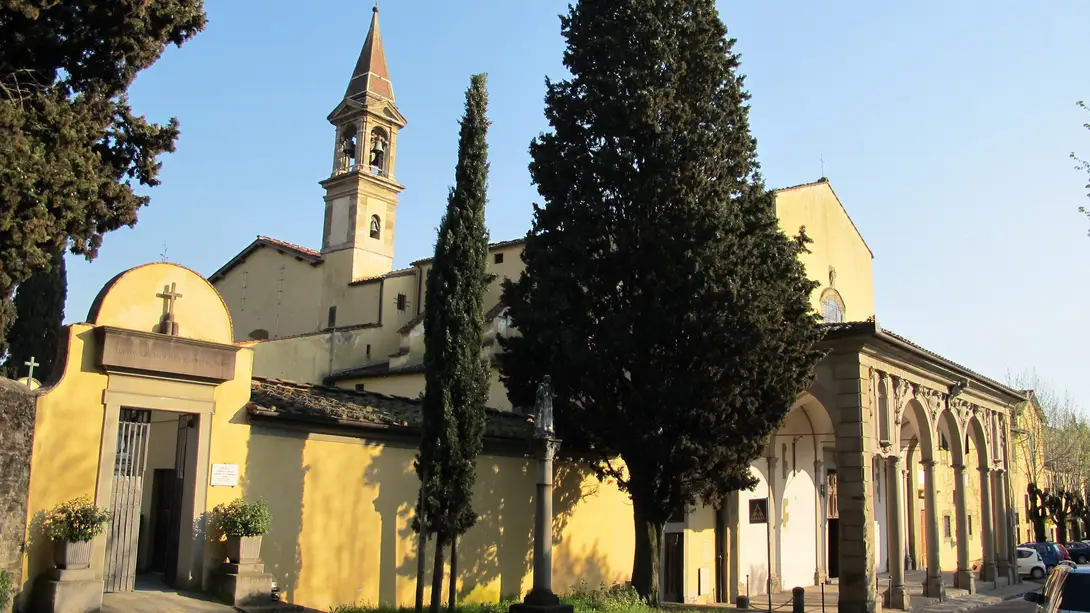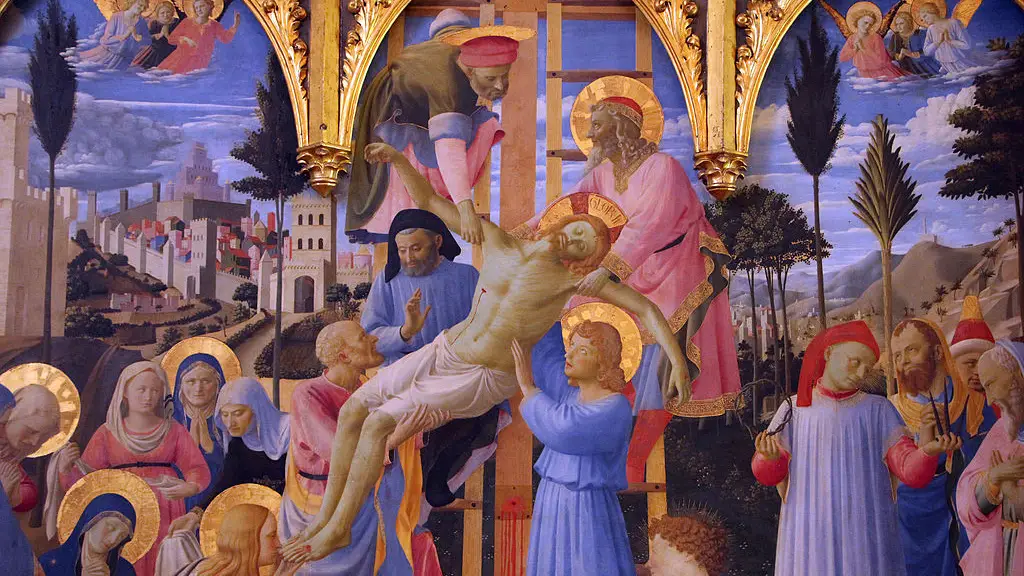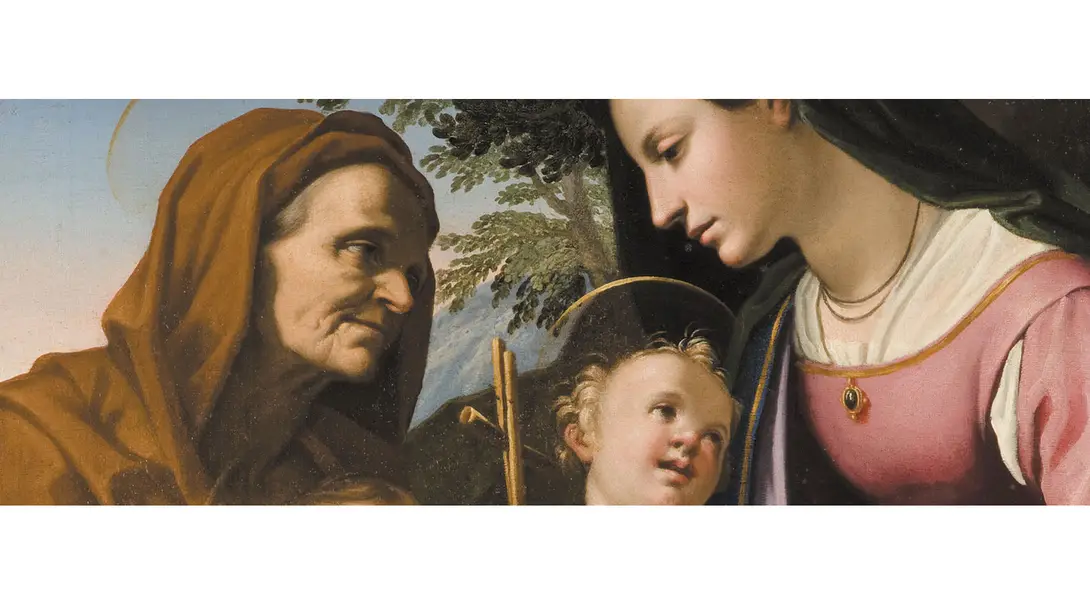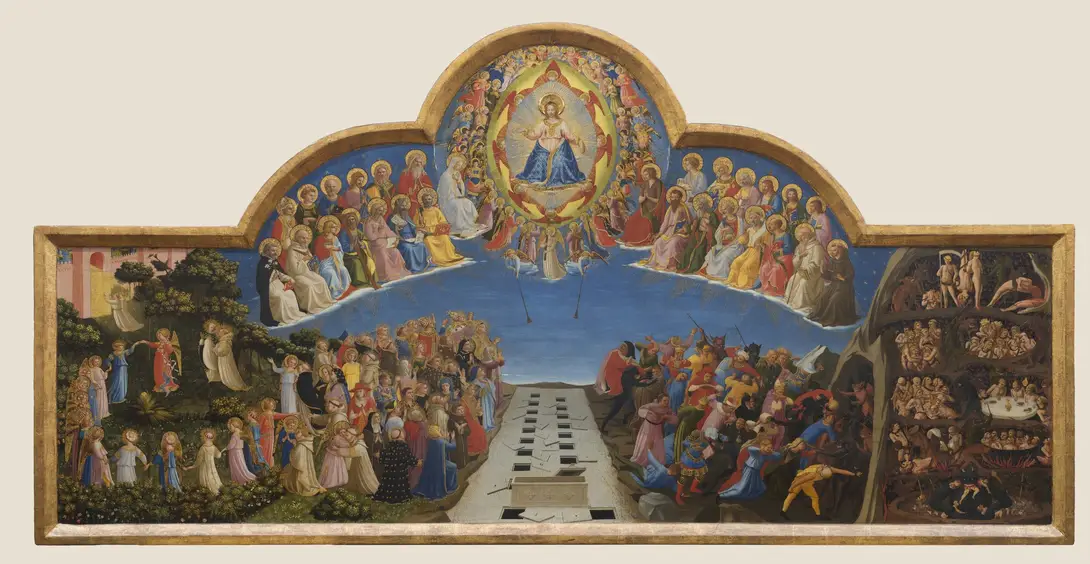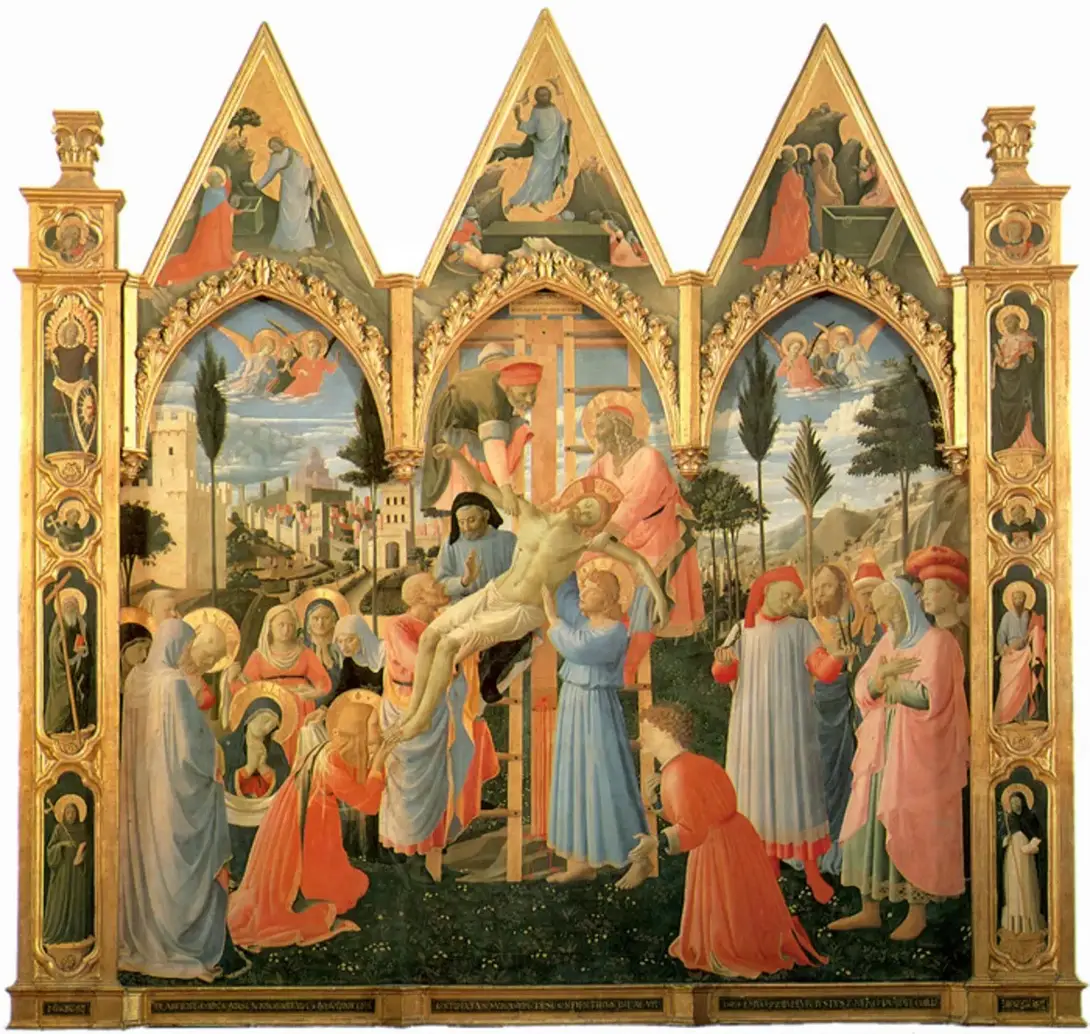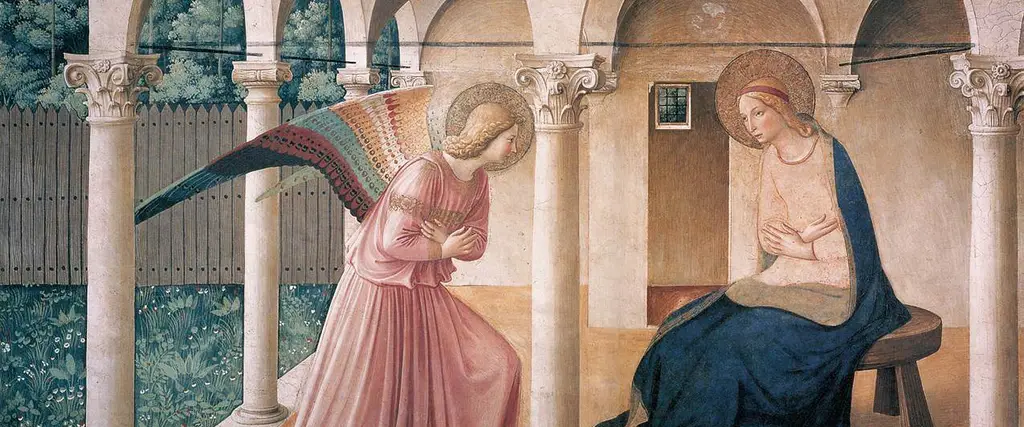
Beato Angelico in and around Florence
Giovanni da Fiesole, better known as Fra' Beato Angelico, was among the most important Italian painters of the first half of the 15th century. Among the many cities in which he worked - including Rome, where he is buried - it is in Florence that we can admire most of his works, many of which are preserved in the Museo di San Marco, the convent where the famous friar-painter lived for many years. His paintings, with exclusively religious subjects, are imbued with delicacy, harmony, brilliant colours and above all light: luminosity and beauty as reflections of God, according to the aesthetics of Saint Thomas Aquinas.
Born in 1395 in Vicchio di Mugello, in the same area where Giotto came from - where there is the "Museum of Sacred Art" named after him (which, however, lacks any of his autograph works) - he had an early artistic education in Florence in the workshop of another brother-painter, Lorenzo Monaco, devoting himself above all to illumination and the decoration of manuscripts. Around 1420, he became a Dominican friar, entering the convent of San Domenico in Fiesole; here he produced a series of early works, including the so-called Fiesole Altarpiece (finished by Lorenzo di Credi) still visible inside the same church, as well as the Annunciation in San Giovanni Valdarno (Museum of the Basilica of Santa Maria delle Grazie).
His artistic evolution is marked from the initial prevalence of late Gothic stylistic features (the elegance of the figures, the ornamentation, the precious details) to the progressive acquisition of the new Renaissance language, first and foremost that of Masaccio (new humanity of the figures, with solid volumes, set in strictly perspective settings).
As anticipated, the highest concentration of Angelico's works is at the Museo di San Marco, inside the large Dominican complex rebuilt during the Renaissance by Michelozzo, at the behest of Cosimo il Vecchio (Cosimo the elder) de' Medici. It is here that the Friar resided and worked from around 1440.
On the ground floor of this complex, in the former guest quarters, is the Sala del Beato Angelico: an extraordinary collection of works on wood by the great painter, where the great Deposition from the Cross, the Madonna dei Linaioli, the Last Judgement, the San Marco Altarpiece and the Annalena Altarpiece stand out; also noteworthy is the great Crucifixion fresco in the chapter house. On the upper floor, however, upon reaching the top of the grand staircase, we are greeted by a splendid frescoed Annunciation (one of his favourite themes); along the corridors are the numerous cells of the Friars - the true heart of the museum - decorated with small frescoes: intimate, essential cues for contemplation and theological reflection, painted by Beato Angelico and his collaborators, including Benozzo Gozzoli. Also along the corridor is the Madonna of the Shadows, painted on Angelico's return from his first stay in Rome (frescoes in the Nicolina Chapel in the Vatican) and from his stay in Orvieto (Duomo, Chapel of San Brizio).
Another extraordinary painting on wood by Angelico, a work of his maturity destined for the Church of Sant'Egidio (Spedale di Santa Maria Nuova), can be found in the Uffizi Gallery: it is the Coronation of the Virgin (1431), a painting on a gold background, animated by a jubilation of saints, angels and musical instruments, where the light spreads through a delicately incised ray.
Around 1450, Angelico left again for Rome, called by Pope Nicholas V, where he died in 1455; his tomb is inside the Church of Santa Maria sopra Minerva, Mother House of the Dominican Order. Although the appellation ‘Beato Angelico’ was consolidated by Giorgio Vasari (16th century), his beatification only took place in 1984, when he was proclaimed Patron Saint of artists, especially painters.
Museo di San Marco
The places
Stages
Church and convent of San Domenico
The convent was built between 1406 and 1435 and here studied two important Dominican monks such as Antonino Pierozzi and Giovanni da Fiesole, also called Beato Angelico, the famous Renaissance friar-painter.
The convent and the church still have some works by Beato Angelico: the triptych, named Pala di San Domenico a Fiesole (in the church, left nave), the Blessing Virgin and the Crucifix (in some not visible areas of the convent). The front porch and the belltower of the church were done by Antonio Nigetti (XVII century).
Museo di San Marco
The St. Mark's Museum, commonly known as the ‘Beato Angelico's museum’, occupies the spaces of the former Dominican convent that Michelozzo rebuilt in Renaissanche style on the commission of Cosimo il Vecchio de' Medici. The charm of this museum is mainly due to the convent's rooms, marked by the works of Beato Angelico, the friar-painter who lived and worked here in the first half of the 15th century.
Numerous panel paintings by Beato Angelico are exhibited in the room dedicated to him on the ground floor. Around the cloister are the rooms in which community life took place: the Hall of the Blessed, the Chapter House (splendid fresco of the Crucifixion). The upper floor, in the corridor and cells, is embellished with an extraordinary cycle of frescoes by Angelico (Annunciation and Stories from the Life of Jesus); in one of these lived the famous preacher Frà Girolamo Savonarola. Also on the first floor is the Monumental Library, a work by Michelozzo in pure Renaissance style.
Returning to the ground floor, one can admire the two refectories (frescoes by Domenico Ghirlandaio and Sogliani), as well as a topographical section with some architectural fragments from the area of Piazza della Repubblica, at the time of the 19th-century redevelopment of Florence as the capital city of Italy (1865-1871).
From 26 September 2025 to 25 January 2026, the Museum will host, together with Palazzo Strozzi, the exhibition Frà Angelico, the largest monographic exhibition ever dedicated to the Florentine painter.
The Uffizi Gallery
With its immense artistic legacy, the Uffizi Gallery, now The Uffizi, is one of the most important museums in the world. Following a substantial reorganization in the 17th century, which led to the transfer of some collections (arms, scientific instruments, archaeological finds, ancient and modern bronzes) to other sites and the establishment of new museums, the Uffizi mainly became a picture gallery, with thousands of works ranging from the 13th to the 18th centuries. After the suppression of churches and convents in the 18th and 19th centuries, many works of ecclesiastical provenance swelled the gallery’s collections; other important paintings were acquired at the beginning of the 20th century.
Masterpieces held in the museum include: the large altarpieces of Cimabue and Giotto; 14th-century Sienese art (including a fine Annunciation by Simone Martini); a rich spectrum of 15th-century art from Tuscany and central Italy, with works by Masaccio and Masolino (Madonna and Child with Saint Anne), Filippo Lippi, Botticelli (Birth of Venus and the Primavera), Piero della Francesca (Portraits of Duke Federico da Montefeltro and his Duchess Battista Sforza of Urbino) and Gentile da Fabriano (Adoration of the Magi).
The rooms devoted to 16th-century painting contain works by the masters of the principal Italian schools: from the Adoration of the Magi by Leonardo da Vinci to Michelangelo and Raphael, while Titian, with his Venus of Urbino, Veronese and Tintoretto represent the flowering of painting in the Veneto. Foreign artists are also well represented, with works by Albrecht Dürer, Hans Holbein and El Greco.
The series of 17th-century works opens with Caravaggio’s Bacchus, and features a rich range of work from the major European schools, including Rubens, Van Dyck and the self-portraits by Rembrandt. Finally, Canaletto and Guardi, together with Longhi and Tiepolo, offer a sample of 18th-century art. In addition, the gallery holds ancient sculptures, miniatures and tapestries from the Medici collections. Work is currently underway on the ‘New Uffizi’, which will double the amount of exhibition space, permitting the display of works previously inaccessible to the public.
A map of suggested paths in the gallery - including their duration - is available on the Uffizi Official Website.
Museum of Sacred Art and Popular Devoutness Beato Angelico
Named after the locally born Beato Angelico, the museum was founded to protect and enhance the religious art works of the area, which have been displayed in such a way that they can be grasped in their historical and religious context, combining the historic and artistic aspect with the anthropological one.
Of particular interest is a Saint John the Baptist in glazed terracotta, attributed to Andrea della Robbia; a mid-15th-century Madonna and Child and a fine Late Gothic panel painting of the Virgin Mary with Saints and Prophets.
